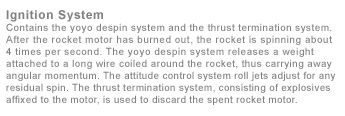

Launching
VAULT
 VAULT
is flown as a sounding rocket payload. Sounding rockets get their name from the nautical
term “sounding,” which means to measure the depth of the water using a weighted line.
Water depth used to be measured in fathoms (a fathom is 6 feet). "Fathom"
also means "to understand" or "to comprehend," so, in a way,
a sounding rocket helps us to measure and comprehend something.
VAULT
is flown as a sounding rocket payload. Sounding rockets get their name from the nautical
term “sounding,” which means to measure the depth of the water using a weighted line.
Water depth used to be measured in fathoms (a fathom is 6 feet). "Fathom"
also means "to understand" or "to comprehend," so, in a way,
a sounding rocket helps us to measure and comprehend something.
Sounding rockets are low cost and provide the only means of making observations between the maximum altitude for balloons (about 30 miles or 48 kilometers) and the minimum altitude for satellites (100 miles or 161 kilometers).
A sounding rocket follows a parabolic trajectory — it goes up and comes back down. Flight time is less than 20 minutes.
The sounding rocket is launched using a booster and a rocket motor. When the booster and rocket motor run out of fuel, they separate from the sounding rocket and fall back to earth. The payload continues into space and begins conducting the experiment. When the experiment is completed, the payload falls back to earth. A parachute opens, allowing the payload to land gently.
VAULT is launched on a Black Brant sounding rocket with a Terrier booster. The Terrier booster burns for only 6 seconds, running out of fuel out at an altitude of 2 miles (3.1 km) and a velocity of 1320 mph (2120 kph). After the Terrier booster separates from the sounding rocket, the Black Brant rocket motor ignites and burns for 32 seconds. The rocket motor runs out of fuel at an altitude of 29 miles (46.5 km) and a velocity of 4820 mph (7750 kph).
After the rocket motor separates, the nosecone is ejected and VAULT is maneuvered to point at the sun. For the rest of the rocket flight, VAULT coasts to its maximum altitude of 182 miles (294 km) and then falls back to earth. The entire flight, from launch to recovery, lasts 15 minutes.
Anatomy of a Sounding Rocket
 |
 |
      |
Learn More
- VAULT Data
- VAULT Mission progress
- VAULT Flight Path
- VAULT Timeline
- VAULT Launch Simulation
- VAULT Sequence of Events
- Launch Video
2003 U.S. Naval Research Laboratory